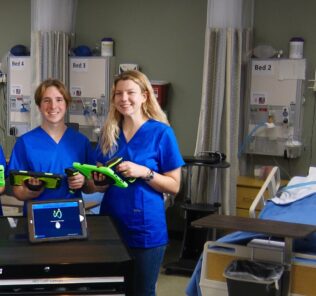Clinical Simulation Escape Room Tips, Tricks & Hacks from IMSH 2021
During the second week of the 2021 International Meeting on Simulation in Healthcare (IMSH) virtual conference, a panel discussion explored escape room tips, tricks and hacks for clinical simulation. The panel, which included Stacy Capel, MSN, Heather Eastman, Julie Hartman, MD, Dyan Anderson, BSN, and John Ding, BS, all possess a range of expertise in healthcare simulation with regard to escape rooms. Their panel discussion objectives were to describe the benefits of using escape rooms with learners, discuss available resources for creating healthcare specific escape room simulations, and to inspire administrators to build and implement their own escape room.
The panel first discussed some basic suggestions for setting up an escape room. As with any healthcare simulation, educators should start by determining specific goals and objectives for the sim and to identify the level of the learners. Clinical simulation educators may need to help faculty that request escape rooms to focus on key specific objectives. Defining clear objectives is critical, and will help determine the construction of the escape room.
For example, determine if the objectives are related to assessment skills, existing protocols, or perhaps to soft skills such as communication or team dynamics. Controlling the transition from one activity to the next, and from one clue to the next, will help keep the learners moving forward and focused on the specified learning objectives. Educators will need to determine which skills the learners will need in order to participate in the escape room. The objectives will determine the puzzles, clues and tests needed for each objective. These objectives in turn will determine the equipment needed.
Sponsored Content:
Time allotted for the escape room needs to be calculated, as well as the time needed to complete individual tasks. The panel recommended five to 10 tasks depending on the time allotted for the escape room. The tasks can be set up so that solving some clues speeds up the escape, or alternatively prolongs the escape. Before the details of the escape room are defined, the type of learner evaluation should be determined.
Will the learners be graded individually or as a team? According to the panel, equipment requirements do not have to be high-fidelity. Cues and transitions have to be predetermined so that learners can meet all the required objectives. Learners may need to locate items or communicate together in order to solve clues. Several suggestions for naming escape rooms were made, for example “Escape The Womb” for a L/D sim, or “Give Falls A Slip” for a sim related to prevention or intervention related to falls.
Objections to Escape Rooms
The panelists noted that escape rooms are not just games or an excuse for time off work, but are created to address practice gaps and other issues such as department-specific safety events, near misses, best practice reinforcement, introducing new policies or equipment, and team-building. Adult and immersive learning theory support learner participation as a method to enhance learning. Use positive learner comments from previous escape room participants to support the efficacy of an escape room experience.
Sponsored Content:
Comments related to human factors such as communication and team-building are helpful. Discuss how the escape room puzzles and cues relate back to objectives. Invite managers and unit-based experts to experience the escape room to see the benefits. An added benefit of having content experts beta-test the escape room is that potential problems can be identified before learners participate.
Money, Money, Money
Determine what equipment is already available, and then develop a budget that covers the likely expenditures. Emphasize the benefits of the escape room and if appropriate, purchase equipment that can be used for other educational activities. Use a printer and laminated cues as an inexpensive way to move learners through the activities. Apart from equipment and consumables, other expenses might include programmable padlocks and USBs. Search the internet for free tips and tricks about how to set up escape rooms (see below for articles about escape rooms from HealthySimulation.com and Laerdal).
Tips and Tricks for Optimizing Escape Rooms
- Have panel members share ideas to make escape room design and preparation go more smoothly. First and foremost, keep the focus on your objectives, and work within the time available to meet learning objectives.
- Predetermine how much time will be allowed to solve puzzles, or whether to allow the escape room to run until the learners solve the puzzle.
- Know your learners. For example, are the learners new graduates or experienced practitioners? This will greatly affect the time flow of a clinical simulation. New grads and undergrads will typically take much longer to complete tasks.
- Keep the room uncluttered and simple, but also resemble the participants’ workspaces as much as possible.
- Provide written instructions/policies.
- Provide a calculator.
- Create a virtual escape room using Google Forms, Slides and Docs for clues. The panel recommends researching YouTube for free instructions on how to create escape rooms. For example, in Google Forms you can create a series of questions which lead to the next clue, and Google Slides can be used to create a room where clues can be hidden.
- A dry run is essential. Have content experts run through escape rooms before the actual learners.
Escape Room Challenge
The panel offered five items that could be used in an escape room. They asked participants to come up with ideas:
- Glow-in-the-dark liquid with a black UV light: this liquid can be used to hide clues that can only be seen when a blacklight is turned on. The liquid can also be used to indicate areas in the room that have become contaminated.
- Magnets: Attach magnets to the back of small 1.5-inch pieces of cards with letters. Put magnets on the back of cards that will spell out the next clue or answer a clue. Provide a magnet on a piece of string, and hide a key in a pipe or bottle that cannot be tipped over. The key should open a box or cupboard with more information.
- Puzzles: Inexpensive puzzles can be bought at a dollar store and may be used in a variety of ways. Puzzle pieces can be hidden about the room, and once the puzzle has been completed, another clue or exit code is revealed. The puzzles may have information written on the back of the puzzle. Puzzles may also be used to simulate time such as waiting for lab results to come back. Create your own puzzles with about 10 pieces to solve a clue. Mix up pieces from two different puzzles to stimulate communication between participants.
- USB drive and computer: USB sticks can be locked. Clues can either lead a learner to a computer to plug in a USB, or the USB can already be in place. In order to open the USB, learners must solve puzzles (e.g. dosage calculations or appropriate compression rates). Various data files can be loaded onto the computer which relate to the escape room, such as: lab results, new orders or medication, EKG findings or hints for the next clue.
- Bike lock: Used to lock access to various pieces of equipment such as ventilators, phones, crash carts or ventilators.
Escape rooms provide a stimulating way to challenge healthcare learners. The panelists urged the audience to not be afraid of using escape rooms, and to not be caught up in the details! As they said, “Just do it.”
Learn more About Escape Rooms
Reference:
- “How Simulation Escape Rooms Can Make Learning Stick” from Laerdal Medical.
Dr. Kim Baily, MSN, PhD, RN, CNE has had a passion for healthcare simulation since she pulled her first sim man out of the closet and into the light in 2002. She has been a full-time educator and director of nursing and was responsible for building and implementing two nursing simulation programs at El Camino College and Pasadena City College in Southern California. Dr. Baily is a member of both INACSL and SSH. She serves as a consultant for emerging clinical simulation programs and has previously chaired Southern California Simulation Collaborative, which supports healthcare professionals working in healthcare simulation in both hospitals and academic institutions throughout Southern California. Dr. Baily has taught a variety of nursing and medical simulation-related courses in a variety of forums, such as on-site simulation in healthcare debriefing workshops and online courses. Since retiring from full time teaching, she has written over 100 healthcare simulation educational articles for HealthySimulation.com while traveling around the country via her RV out of California.
Sponsored Content:


















